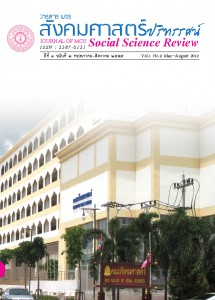การบริหารจัดการความอิจฉา
คำสำคัญ:
การบริหารจัดการ, ความอิจฉาบทคัดย่อ
บทความเรื่องการบริหารจัดการความอิจฉา ความอิจฉานี้เป็นส่วนหนึ่งของกิริยาอาการ ที่แสดง ออกทางอารมณ์ซึ่งฝังตัวหลบซ่อนสายเลือดของมนุษย์ มันเกิดมีมาพร้อมกับการมีชีวิตและลมหายใจทั้งของมนุษย์และสิ่งที่มีชีวิตทุกชนิด ความอิจฉานี้เป็นอาการนามไม่สามารถจับต้องได้ แต่
สามารถรับรู้ได้โดยการแสดงออกทางพฤติกรรมของคนเราที่ตกอยู่ใต้อิทธิพลของอารมณ์ชนิดนี้ครอบงำ มนุษย์เราเคยชินกับพฤติกรรมของความอิจฉาทั้งจากตนเองบ้างและจากคนอื่นบ้างจนกลายเป็นเรื่องปกติแทบไม่ได้คิดว่ามันมีพิษสงเพียงใด และร้ายแรงแค่ไหน ประสบการณ์ที่ได้เห็นทั้ง
จากพฤติกรรมของมนุษย์ในสังคมที่ที่ปรากฏจากที่ต่างๆ และได้ยินได้ฟังจากสื่อชนิดต่างๆ ทั้งทีวี วิทยุและหนังสือ พิมพ์และการบอกเล่าของคนอื่นบ้างจึงอยากจะสืบค้น เสาะแสวงหาถึงสาเหตุ ลักษณะพิษภัยและทางแก้ไขของเพชฌฆาตไร้ตัวตนชนิดนี้
จากพฤติกรรมดังกล่าวนี้ ได้ก่อให้เกิดแรงบันดาลใจอยากรู้ อยากเห็นและอยากสืบค้นหาลักษณะอาการ สาเหตุ โทษและทางแก้ไขของอาการนามชนิดนี้จึงได้ตั้งประเด็นศึกษาในหัวข้อต่างๆ คือ ความอิจฉา คืออะไร มีลักษณะเป็นเช่นไร มีสาเหตุเกิดจากอะไรบ้าง มีโทษอย่างไรและมี
วิธีแก้ไขหรือไม่เพื่อที่จะทำให้เกิดความเข้าใจเกี่ยวกับเรื่องนี้ให้ชัดเจนมากยิ่งขึ้นก่อนที่จะพบกับรายละเอียดที่จะกล่าวต่อไปจึงขอยกเอาประเด็นที่ควรทราบมากล่าวพอเป็นสังเขปคือ ความอิจฉา คืออะไร? มันคืออาการอย่างหนึ่งที่เมื่อเห็นคนอื่นได้ดีกว่า เด่นกว่า เหนือกว่าตนแล้วทนไม่ได้ อารมณ์โกรธ เกลียด แค้นเคียงจะเกิดขึ้นทันทีมีลักษณะเป็นเช่นไร? ความอิจฉาเมื่อทวีความรุนแรงมากขึ้นจะขยายตัวกลายเป็นความโกรธ อาฆาต พยาบาทถึงขั้นกินไม่ได้ นอนไม่หลับและมักจะหาทางเอาชนะโดยวิธีการรุนแรงอย่างใดอย่างหนึ่งมีสาเหตุเกิดจากอะไรบ้าง? ความอิจฉามีสาเหตุมาจากหลายๆอย่างด้วยกัน เพราะ ๑)ความอยากของปัจเจกบุคคล แตกต่างกัน ๒) ความคิดของปัจเจกบุคคล แตกต่างกัน ๓) ปมด้อยของปัจเจกบุคคลแตกต่างกัน ๔) สถานภาพของปัจเจกบุคคล แตกต่างกัน มีโทษอย่างไร? ความอิจฉาจัดเป็นอกุศลธรรมประเภทใฝ่ต่ำ มักทำให้เกิดผลเสียทั้ง
สุขภาพกายและใจ คิดมาก ฟุ้งซ่าน หมดสง่าราศี หากขาดการระงับยับยั้งก็จะหาทางออกในทางที่เป็น อกุศล และอาจนำผลเสียมาสู่ทั้งตนเองและแก่ผู้อื่นได้มีวิธีแก้ไขหรือไม่? ทุกๆ ปัญหาย่อมมีทางแก้ไขอยู่ในตัวของมันเอง ปัญหาทุกปัญหาย่อมมีที่สุดของมันเองเสมอ ไม่มีปัญหาใดที่จะคงอยู่อย่างนั้นตลอดไป ปัญหาเกิดขึ้นด้วยสาเหตุใด ก็จะต้องแก้ไขด้วยสาเหตุนั้น สอดคล้องตามพระพุทธดำรัสที่ตรัสไว้ว่า ธรรมทั้งหลายเกิดแต่เหตุ พระตถาคตเจ้าตรัสบอกถึงเหตุแห่งธรรมเหล่านั้น พร้อมทั้งความดับแห่งเหตุของธรรมเหล่านั้น พระมหาสมณเจ้ามีปกติตรัสสอนอย่างนี้สรุปแล้ว ความอิจฉา คือ ความรู้สึกที่ไม่อยากเห็นคนอื่นได้ดีกว่า ได้ลาภมากกว่า มีชื่อเสียงมากกว่าและทนไม่ได้เมื่อผิดหวัง เกิดความรู้สึกกระวนกระวาย กระสับกระส่าย กินก็ไม่เป็นสุขเห็นเรื่องน่าสนุกกลายเป็นทุกข์ไปเสียสิ้นและจุดจบมักลงเอยด้วยเรื่องน่าเวทนา
เอกสารอ้างอิง
ประกายรุ้ง, ชวนคิดชวนทำ : 9 วิธี เอาชนะความอิจฉาริษยา, [ออนไลน์]. แหล่งที่มา : http://www.manager.co.th/dhamma/viewnews.aspx?NewsID=9540000067 754 [๒๔ พ.ค. ๒๕๕๖].
พระไตรปิฎก ฉบับสยามรัฐ, รถกถา ขุททกนิกาย คาถาธรรมบท อัปปมาทวรรคที่ ๒ หน้า ๑๕.
พระราชภาวนาวิสุทธิ์ (ไชยบูลย์ ธมฺมชโย), โทษของความอิจฉาริษยา, [ออนไลน์]. แหล่งที่มา : buddha.dmc.tv/ธรรมะเพื่อประชาชน/โทษของความอิจฉาริษยา.html[๒๓ มิ.ย. ๒๕๕๖].
มูลนิธิศึกษาและเผยแผ่พระพุทธศาสนา, ๒๐๑๒ โลกจะแตกจริงหรือ?, [ออนไลน์]. แหล่งที่มา : http://www.dhammahome.com/front/webboard/show.php?id=20529 [๒๓ ม.ย. ๒๕๕๖].
วิทยา นาควัชระ. หนังสือพิมพ์แนวหน้า ฉบับวันจันทร์ ที่ ๓๑ ธันวาคม พ.ศ. ๒๕๕๕.
ดาวน์โหลด
เผยแพร่แล้ว
รูปแบบการอ้างอิง
ฉบับ
ประเภทบทความ
สัญญาอนุญาต
ลิขสิทธิ์ (c) 2018 วารสาร มจร สังคมศาสตร์ปริทรรศน์

อนุญาตภายใต้เงื่อนไข Creative Commons Attribution-NonCommercial-NoDerivatives 4.0 International License.
เพื่อให้เป็นไปตามกฎหมายลิขสิทธิ์ ผู้นิพนธ์ทุกท่านต้องลงลายมือชื่อในแบบฟอร์มใบมอบลิขสิทธิ์บทความให้แก่วารสารฯ พร้อมกับบทความต้นฉบับที่ได้แก้ไขครั้งสุดท้าย นอกจากนี้ ผู้นิพนธ์ทุกท่านต้องยืนยันว่าบทความต้นฉบับที่ส่งมาตีพิมพ์นั้น ได้ส่งมาตีพิมพ์เฉพาะในวารสาร มจร สังคมศาสตร์ปริทรรศน์ เพียงแห่งเดียวเท่านั้น หากมีการใช้ภาพหรือตารางหรือเนื้อหาอื่นๆ ของผู้นิพนธ์อื่นที่ปรากฏในสิ่งตีพิมพ์อื่นมาแล้ว ผู้นิพนธ์ต้องขออนุญาตเจ้าของลิขสิทธิ์ก่อน พร้อมทั้งแสดงหนังสือที่ได้รับการยินยอมต่อบรรณาธิการ ก่อนที่บทความจะได้รับการตีพิมพ์ หากไม่เป็นไปตามข้อกำหนดเบื้องต้น ทางวารสารจะถอดบทความของท่านออกโดยไม่มีข้อยกเว้นใดๆ ทั้งสิ้น





